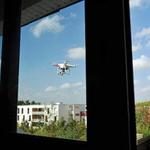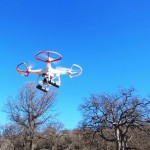By Ariel Herbert-Voss, Greyson Harness, and Nicolas Goller
FAA Logos are property of the Federal Aviation Administration.
Drones and satellite flyovers reveal details about lost civilizations – 14 February 2015
During the annual meeting of the American Association for the Advancement of Science, three researchers from the European Research Council discussed how advances in imaging technologies and UAVs are aiding in research investigating the historical role of human activity in shaping Amazonian and Saharan landscapes. Since both of these regions are difficult to do fieldwork because of their isolated nature, drones outfitted with LIDAR can help reveal images of previously unreachable structures and other sites of archeological importance. The hope is that by integrating drone technology into site work, researchers can analyze images to learn more about the evolution of ancient societies.
US drone rules impact Amazon plans – 16 February 2015
The Federal Aviation Administration (FAA) came out this week with a draft of rules for drones in US airspace. Regulations include that pilots will remain within eyesight of their drone, and must be certified by the FAA. These rules may prove contentious, but are not expected to come into force for several years while the draft rules are open to public consultation. The draft rules are most notable for putting Amazon’s drone delivery program on hiatus, due to the line of sight rule.
FAA unveils drone rules; Obama orders policy for agencies – 16 February 2015
Just this last Saturday, the FAA laid out their plan for governing small commercial drones. The plan requires that the UAV operators of up to fifty-five pound drones keep their drone within sight, stay under 100 mph, are at least seventeen years of age, and have the Transportation Security Administration’s authorization. Some critics claim drones under a few pounds should have fewer restrictions. The public will have sixty days to comment on this proposal. Some experts expect comment analysis and rule revision to take no less than eighteen months. On Sunday, Obama signed off on a memo that will help drone use be more transparent and ensure that personal liberties are guaranteed.
Amsterdam To Host World’s First Drone Circus With Royal Netherlands Air Force In 2015 – 18 February 2015
Hundreds of drones will be on parade in Amsterdam Arena come fall 2015. AIR 2015, the first drone circus, will feature hundreds of drones racing, dancing, and performing stunts. The Royal Netherlands Air Force is apparently helping put on the show. The preview video encourages us to expect ballet and battles, races and lasers, circus and illusions, and magic and machines. Walt Disney also has plans to use drones in their theme parks. Needless to say, expect some big changes in live entertainment in the coming years!
Solace Power Takes Aim At Wireless Mid-Flight Charging For Drones – 18 February 2015
Providing the necessary power to keep a drone aloft is not trivial. Many unmanned aerial vehicles can barely remain airborne for fifteen minutes. It is precisely this issue that Canadian startup Solace Power seeks to fix. They use resonant capacitive coupling technology to charge drones wirelessly. In their recently released video, they demonstrate how a drone hovering over a special plate charges. The video demonstrates that while Solace Power’s innovations are exciting, they might still need some work before they are adopted on a grand scale. The current technology probably has already some applications in factories. Drones are special possess the special ability to get to vantage points and locations that are not otherwise accessible. Hopefully Solace Power’s work can support unmanned aerial vehicles in these less accessible environment as well!
Why the U.S. Plans to Sell Drones – 18 February 2015
On Tuesday, Obama announced plans to begin selling armed United States drones to allies. Part of this decision comes from a high demand for drones abroad and from increased terrorist activity. With the Islamic State and other terrorist organizations maintaining an active presence in the Middle East, it is beneficial for the United States to sell drones to its allies to aid in the war against terrorism. This move will also contribute significantly to the drone industry, an industry expected to house over one hundred thousand jobs and be worth more than eighty-two billion dollars by the end of the decade.
Cambodia Bans Drones – 19 February 2015
On Monday, drones were banned from the airspace of Phnom Penh, in the interest of privacy and safety. The directive specifically mentions drones equipped with a camera, leading some to believe that this move was made primarily to avoid people being able to videotape and take pictures of unsuspecting persons. It has also been suggested that this was a political move, made to deny the current regime’s opponents access to a technology that could potentially undermine their authority, such as in cases of reporting civil unrest.
Training falcons with drones – 19 February 2015
Falconers in the United Arab Emirates are using drones to train their birds by floating food lures for the birds to grab during flight. Falcons hunt by scanning a conical area between themselves and the ground, so there isn’t much incentive for the bird to search above the conical region. In order to get birds to fly higher as part of showmanship routines, falconers traditionally create lures to tie to hand-made kites. The falcon grabs the lure from the kite and then flies back to the trainer to exchange the lure for food. The falconer can then train the bird to fly higher by increasing the height of the kite. The advantage of using drones is the increase of control, as kites can only go as high as the string.
Eco-Drones Aid Researchers in Fight to Save the Environment – 20 February 2015
Drones are saving the planet! Whales are probably grateful of their little hovering guardians. When the whales approached areas where they might get hunted (e.g. The Faroe Islands), conservationists went out in boats and scared them off. BioCarbon Engineering has created a tree-planting drone. It shoots little balls of germinated seeds and fertilizer. The company is hoping this technology can be used to combat deforestation in the near future. They entered their drone into the UAE Drones for Good competition. The winner of the competition will receive one million dollars. An MIT team submitted the Waterfly. They make use of a swarm of drones to test for dangerous cyanobacteria in water.



